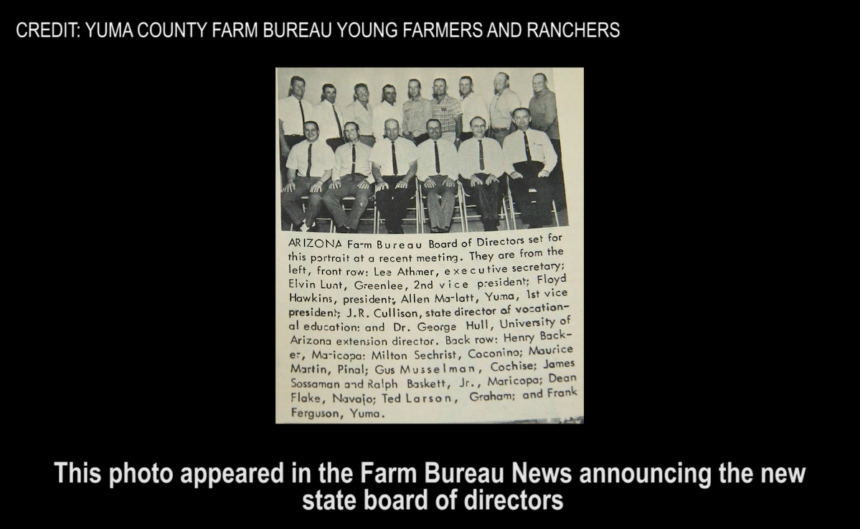Home Grown Exclusive: Back to Ag. Roots

100 Years of the Yuma County Farm Bureau
YUMA, Ariz. (KECY, KYMA) - The agriculture industry has been a staple to Yuma County for many years, and so has the organization committed to keeping a steady force with a lasting impact.
In the next few weeks, we will be taking a look at the last 100 years of agriculture in celebration of the Yuma County Farm Bureau centennial.
In these exclusive pieces - “Back To Ag. Roots”, we will be talking to local farmers about the past 100 years of Yuma's agriculture, their present endeavors, and looking towards the future of farming.
Even before the well known Yuma farmers, there were indigenous farmers, according to the Arizona Department of Agriculture: “predate Arizona statehood by several hundred years, with some areas going back centuries.”
These indigenous farmers were the start of something big for Yuma county.
For example, though you may not remember January 8, 1920, some farmers remember it as a day marking history being made.

This was the day that the Yuma County Farm Bureau was established, a grassroots organization made by farmers for farmers.
“There’s a whole long litany of things that have been done to make Yuma agriculture so strong. One of those is being the Foundation of the Yuma County Farm Bureau because you needed a platform in which growers can come together,” said David Sharp, president of the Yuma County Farm Bureau.
The 1920s were a roaring time for farmers, this new bureau gave farmers an opportunity to voice concerns with interests of the day-business, manufacturing, railroads, and labor.
The Yuma Farm Bureau was a county-wide advocate for farmers through the good times and bad, with a core belief that a successful agriculture industry would contribute to not only Yuma’s well-being but also America’s.

“It was simply because the farmers realized that there was a need for some unity,” said Sharp.
In addition to meeting within Yuma county, representatives of the farm bureau had the responsibility to fight for farmers in Washington.
“These weren’t professional lobbyists that went back to Washington, these were just everyday farmers who saw the need and stepped out and did it,” said Sharp.
One of the first examples is the Farm Bloc, a bipartisan group of senators and congressmen, that brought forth The Packers and Stockyard Act requiring meatpackers to engage in fair practices in 1921.
County Farm Bureaus existed but were mainly about educating the farmer, not necessarily impacting farm policy.
“Many times, ideas that have been brought up and thought about here in Yuma, have ended up even at the national level, and made a big impact on American agriculture,” said Sharp.

It wasn’t until after American farmers and ranchers played a critical role in winning World War I, that farmers realized they needed a unified voice.
“Being a farmer is who we are, what we are, it’s a way of life for us,” said Sharp.
County Farm Bureaus united across the nation, working together to further the industry.
That’s when the American Farm Bureau took the lead in drafting the Agricultural Adjustment Act of 1933, the first piece of New Deal legislation.
The farm bureau defended farmers when it came to the proper use of pesticides.
Other monumental actions of the farm bureau include leading the way on protecting rancher’s property rights, expanding the use of eminent domains, and setting a renewable fuels standard that reduced reliance on foreign oil.
Most recently, in 2016, President Obama signed a GMO labeling law supported by the Farm Bureau, in hopes to decrease consumer confusion on GMO’s.
A major benefit to the farm bureau since its beginning was the chance for farmers to come together to discuss their ideas when it comes to agriculture production.
“Being a part of the Farm Bureau, the association, the people that I’ve met through the Farm Bureau, the friends that I have from Farm Bureau, you can’t beat that,” said Sharp.
These ideas have been a big factor to Yuma’s role as the winter vegetable capital of the nation.
Over the last 100 years, Yuma farmers have rapidly adjusted to the latest production technologies.

“And many of the things that have become so efficient in much of the world, were tried and tested here in Yuma. The way we irrigate, the way we level our fields, moving from leveling the fields with a grade stick, to using a laser, and then eventually moving on to GPS,” said Sharp.
Here is a list of some other agriculture innovations:
1980: Laser leveling
1980: Sprinkler irrigation
1981: Ditch/canal modifications
1987: Drip irrigation
1990: GPS/GIS becomes mainstream
1993: Precision techniques
1997: Biotech crops available
All in all, the Yuma County Farm Bureau has played a major role in fighting for farmers whether it be at the farm bureau office during a meeting, or voting on state-level issues in Washington.
“There have been so many accomplishments that have been done in Yuma. I credit a lot of that to the leadership and the strength of the growers and farmers and landowners that have been in Yuma for the last 100 years,” said Sharp.
A hundred years ago, Herbert Hoover – then the Head of the U.S. Food Administration- is quoted as saying, “Who speaks for agriculture anyhow?”

Well when you look to the Yuma County Farm Bureau, you see multiple generations of growers who speak with one voice, focused on the sustainability of food for Yuma, the state of Arizona, and the world.
The Yuma County Farm Bureau has played a major role in fighting for farmers whether it be at the farm bureau office during a meeting or voting on state-level issues in Washington.
Stay tuned next week as Arianna Shell speaks to an educator within the ag. industry to learn about the importance of continued education when it comes to farming.
